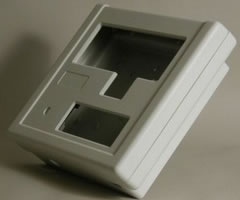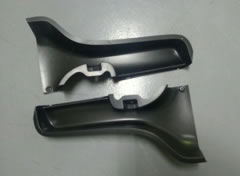Product List
Plastic Thermoforming
Description
Plastic thermoforming is a process of heating a thermoplastic sheet to its softening point, stretching it over or into a single-sided mold, then holding it in place while it cools and solidifies into the desired shape. It can produce very large parts with high production rate and low cost.
Thermal Forming Process
1. The thermoplastic sheet is clamped into a holding device and heated by an oven using either convection or radiant heat until it is softened.
2. The sheet is then held horizontally over a mold and pressed into or stretched over the mold using vacuum pressure, air pressure or mechanical force.
3. The softened sheet conforms to the shape of the mold and is held in place until it cools.
4. The excess material is then trimmed away and the formed part is released. Excess material can be reground, mixed with unused plastic, and reformed into thermoplastic sheets.
Plastic Thermoforming
Application
1. Thermal forming is commonly used for food packaging, which has many applications from plastic toys to aircraft windscreens and cafeteria trays.
2. Thin-gauge (less than 0.060 inches) sheets are mostly used for rigid or disposable packaging, while thick-gauge (greater than 0.120 inches) sheets are typically used for cosmetic permanent surfaces on automobiles, shower enclosures, and electronic equipment.
Plastic Thermoforming Types
1. Vacuum forming: A vacuum is formed between the mold cavity and the thermoplastic sheet. The vacuum pressure forces the sheet to conform to the mold and form the part shape.
2. Pressure forming: In addition to utilizing a vacuum underneath the sheet, air pressure is applied on the back side of the sheet to help force it onto the mold. This additional force allows the forming of thicker sheets and creating finer details, textures, undercuts, and sharp corners.
3. Mechanical forming: The thermoplastic sheet is mechanically forced into or around the mold by direct contact. Typically, a core plug will push the sheet into the mold cavity and force it into the desired shape.
Common Materials for Plastic Thermoforming
Commitment
1. We provides a high quality affordable plastic thermoforming, plastic thermal forming solution according to customer requirements.
2. we will ensure the following services: suitable materials, affordable cost, reliable quality, test report and stable delivery.
3. We are able to utilize our low cost structures in China, and provide a low cost and reliable final plastic thermoforming products, lower than almost any other countries plastic thermal forming service supplier.
Plastic thermoforming is a process of heating a thermoplastic sheet to its softening point, stretching it over or into a single-sided mold, then holding it in place while it cools and solidifies into the desired shape. It can produce very large parts with high production rate and low cost.
Thermal Forming Process
1. The thermoplastic sheet is clamped into a holding device and heated by an oven using either convection or radiant heat until it is softened.
2. The sheet is then held horizontally over a mold and pressed into or stretched over the mold using vacuum pressure, air pressure or mechanical force.
3. The softened sheet conforms to the shape of the mold and is held in place until it cools.
4. The excess material is then trimmed away and the formed part is released. Excess material can be reground, mixed with unused plastic, and reformed into thermoplastic sheets.
Plastic Thermoforming

|

|

|

|

|

|

|

|
Application
1. Thermal forming is commonly used for food packaging, which has many applications from plastic toys to aircraft windscreens and cafeteria trays.
2. Thin-gauge (less than 0.060 inches) sheets are mostly used for rigid or disposable packaging, while thick-gauge (greater than 0.120 inches) sheets are typically used for cosmetic permanent surfaces on automobiles, shower enclosures, and electronic equipment.
Plastic Thermoforming Types
1. Vacuum forming: A vacuum is formed between the mold cavity and the thermoplastic sheet. The vacuum pressure forces the sheet to conform to the mold and form the part shape.
2. Pressure forming: In addition to utilizing a vacuum underneath the sheet, air pressure is applied on the back side of the sheet to help force it onto the mold. This additional force allows the forming of thicker sheets and creating finer details, textures, undercuts, and sharp corners.
3. Mechanical forming: The thermoplastic sheet is mechanically forced into or around the mold by direct contact. Typically, a core plug will push the sheet into the mold cavity and force it into the desired shape.
Common Materials for Plastic Thermoforming
| Material name | Abbreviation | Description | Applications |
| Acrylic | PMMA | Rigid, brittle, scratch resistant, transparent, optical clarity, low/medium cost | Display stands, knobs, lenses, light housings, panels, reflectors, signs, shelves, trays |
| Acrylonitrile Butadiene Styrene | ABS | Strong, flexible, low mold shrinkage (tight tolerances), chemical resistance, electroplating capability, naturally opaque, low/medium cost | Automotive (consoles, panels, trim, vents), boxes, gauges, housings, inhalors, toys |
| Cellulose Acetate | CA | Tough, transparent, high cost | Handles, eyeglass frames |
| Polyethylene - Low Density | LDPE | Lightweight, tough and flexible, excellent chemical resistance, natural waxy appearance, low cost | Kitchenware, housings, covers, and containers |
| Polyethylene - High Density | HDPE | Tough and stiff, excellent chemical resistance, natural waxy appearance, low cost | Chair seats, housings, covers, and containers |
| Polypropylene | PP | Lightweight, heat resistance, high chemical resistance, scratch resistance, natural waxy appearance, tough and stiff, low cost. | Automotive (bumpers, covers, trim), bottles, caps, crates, handles, housings |
| Polyvinyl Chloride - Plasticised | PVC | Tough, flexible, flame resistance, transparent or opaque, low cost | Electrical insulation, housewares, medical tubing, shoe soles, toys |
Commitment
1. We provides a high quality affordable plastic thermoforming, plastic thermal forming solution according to customer requirements.
2. we will ensure the following services: suitable materials, affordable cost, reliable quality, test report and stable delivery.
3. We are able to utilize our low cost structures in China, and provide a low cost and reliable final plastic thermoforming products, lower than almost any other countries plastic thermal forming service supplier.
Inquire Now!
Related Searches: Custom Plastic Thermoforming | Vacuum Thermal Forming | Custom Thermoforming | Thermoformed Plastic
 English
English




